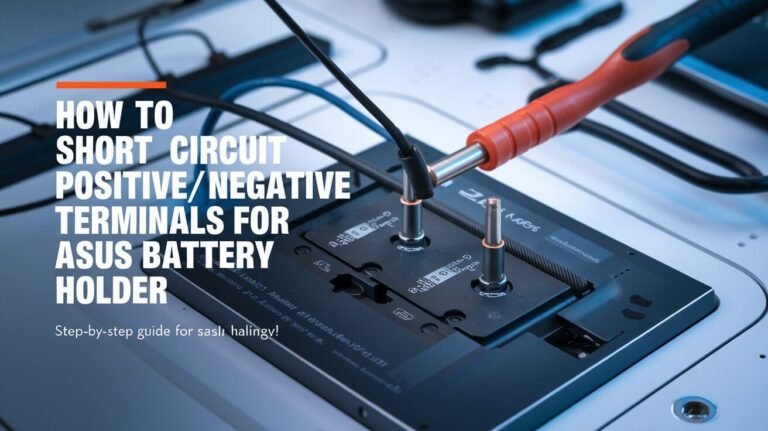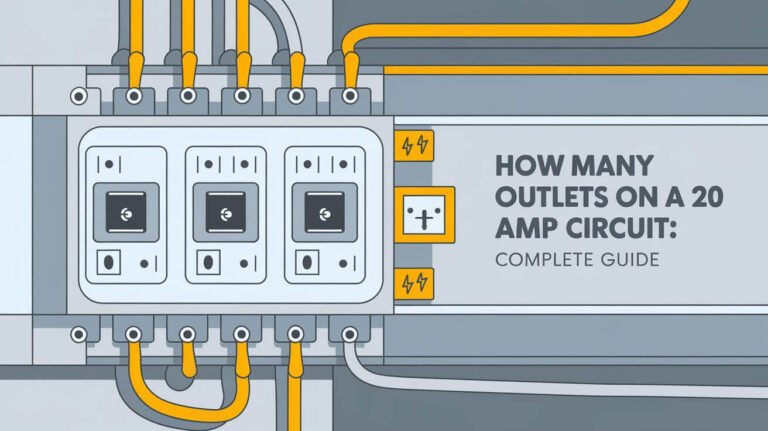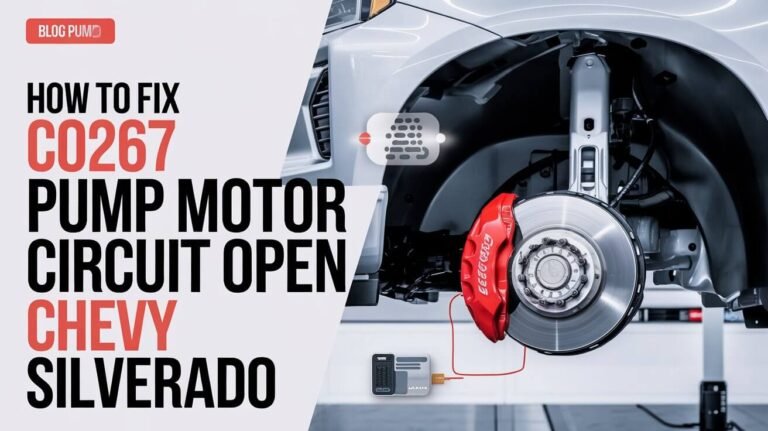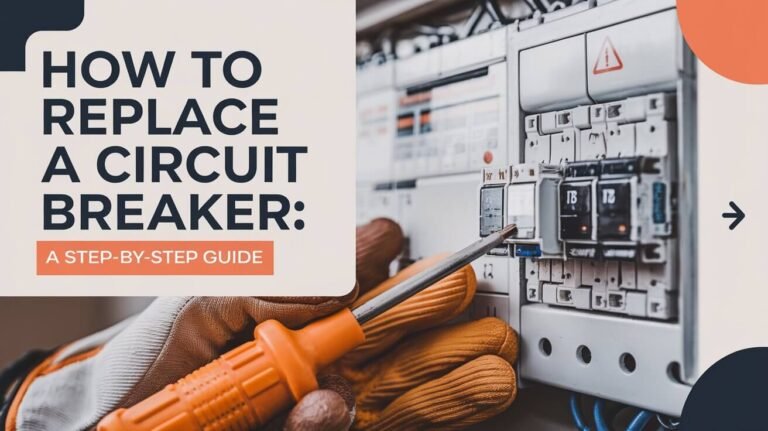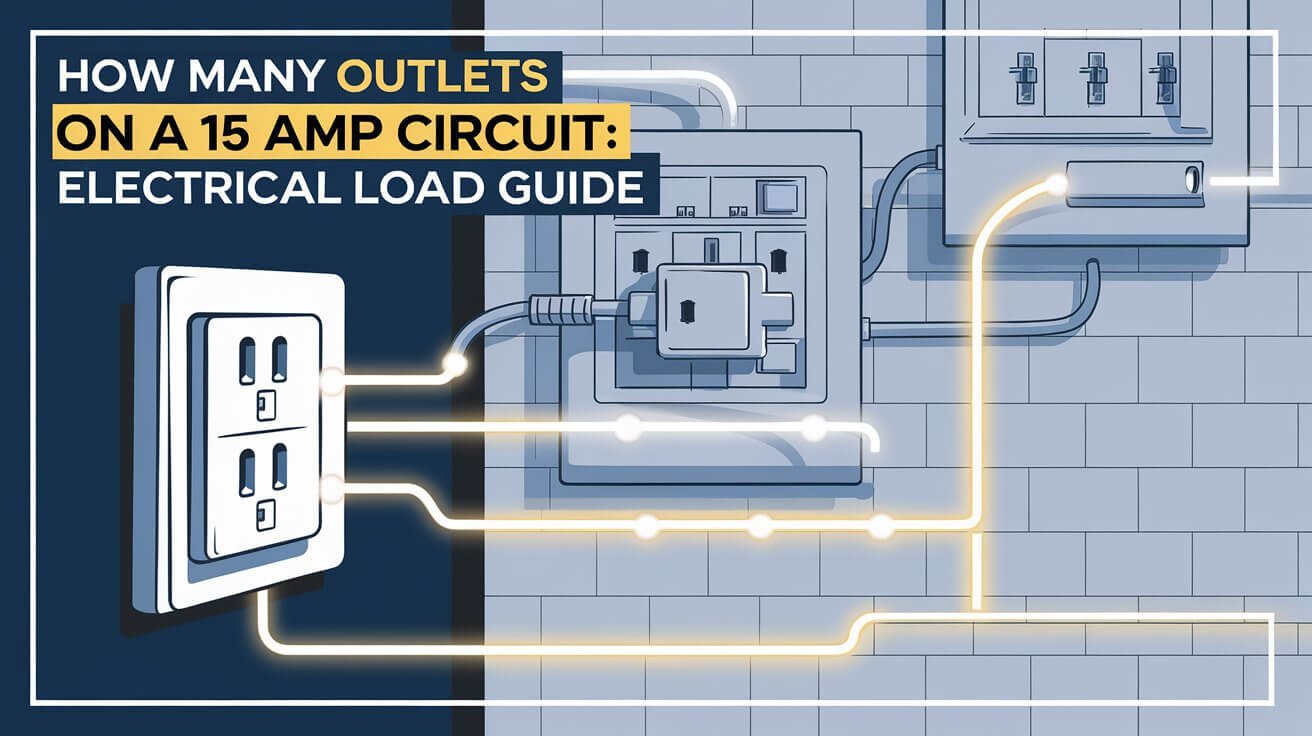
Ever thought about how many outlets you can safely have on a 15-amp circuit at home? This is a key question for keeping your electrical system safe and efficient. In this article, we’ll dive into the important rules and safety tips every homeowner needs to know. This will help make sure your electrical setup is safe and works well.
Basic Principles of 15 Amp Circuit Design
It’s important to know the basics of a 15-amp electrical circuit for safe wiring at home. A 15-amp circuit has many outlets and special slots for wires. It has a big slot for the neutral wire and a small one for the power lead. There’s also a slot for the ground wire.
Unlike 20-amp outlets, 15-amp outlets don’t have a T-shaped hole for the neutral wire.
Components of a Standard Circuit
The National Electrical Code (NEC) says you can have up to 12 outlets on one 15-amp circuit. Today’s outlets need arc fault breakers. These breakers quickly stop the circuit if they find an electrical arc.
Current Flow and Circuit Capacity
A 15-amp circuit can handle up to 15 amps of current. But, electricians usually aim for 12 amps to stay safe. This extra space helps the circuit handle sudden increases in power without tripping the breaker.
Safety Standards and Regulations
Electrical codes and safety rules, like the NEC, guide how to design and install 15-amp circuits. They cover things like how many outlets you can have, how to calculate loads, and the right circuit protection devices. Following these rules is key to keeping your home’s electrical system safe and reliable.
How Many Outlets On A 15 Amp Circuit
Installing outlets on a 15 amp circuit needs careful planning. The National Electrical Code says up to 12 outlets can go on a 15-amp circuit. Yet, most electricians suggest a safer limit of 8 outlets to avoid overloading and circuit breaker trips.
It’s key to figure out the total electrical load of devices connected. This is to make sure you don’t go over the circuit’s 15-amp limit. The 80% rule is a good guide to follow. It helps keep the circuit safe and prevents overloading.
| Circuit Capacity | Recommended Maximum Outlets |
|---|---|
| 15 Amp Circuit | 8 Outlets |
| 20 Amp Circuit | 10 Outlets |
Even though the National Electrical Code allows up to 12 outlets on a 15-amp circuit, it’s important to think about the devices connected. Also, shared circuits and circuit breaker design play a role in preventing overload. Overloading can cause the circuit breaker to trip, cutting off power. It can even lead to overheating wires and fires.
Always get a professional electrician for outlet installation or upgrades. They ensure your place is wired safely and meets local codes. Following these guidelines helps avoid electrical loads and keeps your 15-amp circuit reliable for the long term.
Circuit Load Calculations and Safety Limits
Electrical circuits in our homes must be safe. The 80% load rule is key. It says a 15-amp circuit should not carry more than 12 amps. This rule helps avoid overheating and fires, keeping your circuit breakers working well.
The 80% Load Rule
When figuring out electrical loads, remember both constant and occasional uses. The NEC suggests no more than 8 outlets on a 15-amp circuit. Each outlet uses about 1.5 amps, keeping the load under 80% safe.
Power Distribution Guidelines
Good power distribution is vital for safety and efficiency. Some circuits are too full, while others are too empty. For example, a 15-amp circuit with four 300-Watt devices leaves little room for lights and other low-power items.
Peak Load Management
- Identify high-power appliances and ensure they have dedicated circuits to prevent overloading.
- Monitor the total electrical load on each circuit and make adjustments as needed to stay within the 80% safety threshold.
- Consider upgrading to 20-amp circuits in areas with multiple high-draw devices to accommodate increased power demands.
Following these guidelines, you can keep your electrical system safe and efficient. It will meet your home’s power needs well.
Residential Wiring Requirements for 15 Amp Circuits
The 15-amp circuit is a common choice for homes. It follows specific rules to ensure safety and meet electrical codes. Let’s look at the main rules for 15-amp circuits in various home areas.
In bedrooms, we usually install three or four outlet receptacles. We also add lighting and arc fault breakers. Kitchens have stricter rules because of the power needed for big appliances. These include the range/oven, dishwasher, and refrigerator.
Smoke detectors don’t count towards the 12-outlet rule. They can be placed as needed around the house. For continuous lighting, up to 1500 watts can run on one 15-amp circuit.
Following the National Electrical Code (NEC) is key for safe outlet installation. The NEC sets rules for outlet numbers and placement. It also dictates wire gauges and circuit breaker sizes for 15-amp circuits.
Sticking to these wiring rules, homeowners get a safe and dependable electrical system. It will meet all electrical codes and standards.
Common Appliance Power Demands
When designing electrical circuits, it’s key to know the power needs of common household appliances. The power demands of appliances can affect a circuit’s capacity and safety. We’ll look at the differences between high-draw devices and low-draw electronics. This will help you plan your home’s electrical system.
High-Draw Devices
Appliances like washing machines, refrigerators, and ovens use a lot of power. They need their own circuits to work safely and avoid overloading. For example, a washing machine can use up to 1,200 watts. A full-size refrigerator might need 600-800 watts.
These high-power appliances need their own circuits. This prevents breakers from tripping and avoids electrical problems.
Low-Draw Electronics
On the other hand, devices like laptops, TVs, and LED light bulbs use less power. They can usually share circuits without straining the system. For example, a 42-inch LCD TV might only need 120-200 watts. An 9-watt LED light bulb uses much less power than a 60-watt incandescent bulb.
Even though low-draw electronics can share circuits, don’t overload them. Any load over 1,500 watts should have its own circuit. This ensures safe and reliable use.
| Appliance | Wattage |
|---|---|
| Incandescent Light Bulb | 60W |
| LED Light Bulb | 9W |
| Laptop | 50-100W |
| 42″ LCD TV | 120-200W |
| Microwave | 1,000W |
| Coffee Maker | 800W |
| Hair Dryer | 1,500W |
| Vacuum Cleaner | 1,200W |
Circuit Breaker Protection Systems
Keeping our homes and workplaces safe from electrical dangers is key. Circuit breaker protection systems are vital for this. They watch over the electricity flow, stopping short circuits, overloaded circuits, and fires.
At the heart of today’s safety are arc fault breakers. These cost about $80 each and are needed for new outlets. They can spot electrical arcs and quickly cut off power to avoid accidents.
On the other hand, regular circuit breakers cost around $7 each. They work by tripping when the current is too high, usually over 15 amps. This helps avoid overheating and fires.
Circuit breakers are a must for any electrical setup. Knowing how they work helps keep us safe. By understanding the different types, we can protect our spaces from electrical safety risks.
| Circuit Breaker Type | Cost per Unit | Key Function |
|---|---|---|
| Arc Fault Breakers | $80 | Detect electrical arcs and interrupt the circuit to prevent electrical hazards |
| Conventional Breakers | $7 | Trip the circuit when current exceeds the rated capacity, typically 15 amps, to prevent overloaded circuits and fire risks |
Special Considerations for Kitchen and Bathroom Circuits
Kitchens and bathrooms need special care when it comes to electrical wiring. They face unique challenges because of water and powerful appliances. To keep our electrical systems safe and reliable, we must follow certain rules and guidelines.
GFCI Protection Requirements
GFCI (Ground Fault Circuit Interrupter) protection is a must in kitchens and bathrooms. These devices quickly stop power if there’s a ground fault. This helps prevent electric shocks and electrocution, keeping our loved ones safe.
Dedicated Circuit Needs
Kitchen and bathroom appliances use a lot of power, needing their own circuits. This ensures that a big appliance like a dishwasher or stove doesn’t overload the system. Proper circuit design and load management are key for a safe electrical network at home.
In older homes, kitchens might only have a few circuits. This is not enough for today’s appliances and electronics. The building code often requires adding more circuits and AFCI protection during new construction or big kitchen remodels. It’s important to make sure all 15-amp and 20-amp circuits in kitchens have AFCI protection to prevent fires.
The National Electrical Code (NEC) also has rules for kitchen counter receptacles. They must be no more than 48 inches apart and tamper-resistant. These standards help ensure safe and convenient power distribution in kitchens.
Understanding the importance of GFCI protection and dedicated circuits in kitchen wiring and bathroom wiring helps homeowners and electricians create safer and more efficient electrical systems. This is crucial for these critical areas of our homes.
Upgrading from 15 Amp to 20 Amp Circuits
As our homes get more tech-savvy and power-hungry, moving from a 15-amp to a 20-amp circuit is wise. This change can support high-draw appliances like refrigerators, electric stoves, and air conditioners. It prevents overloading your electrical system.
Before starting a circuit upgrade, it’s key to check your home’s electrical setup. Our skilled electricians will look at your wiring, circuit breakers, and electrical panel. They ensure the upgrade fits your home’s power needs.
Upgrading without checking your electrical system can be risky. It might cause overheating or even fires. That’s why we suggest hiring a licensed and insured electrician, like our team. They ensure your upgrades are done safely and meet all codes.

